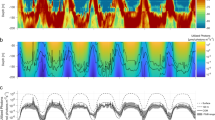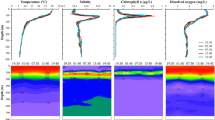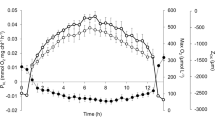Abstract
THE solar eclipse of March 7, 1970, provided an opportunity to examine the reactions of zooplankton. to rapid changes in light intensities. Diurnal changes in the vertical distribution of zooplankton are recognized behavioural phenomena1,2. Light is considered to be the principal stimulus to vertical movement in planktonic crustaceans3,4. The basic pattern of diurnal distribution is a rise to the surface in late afternoon in response to decreasing light intensity, followed by a sinking in the absence of a light gradient at night; as light increases at dawn the zooplankton moves upward to the source of light change, and then downward away from the increasing intensity of daylight2. The general pattern of movement can vary, however, under the influence of various exogenous and endogenous conditions5. Observations of the responses of zooplankton to solar eclipses are limited to the studies of Petipa6, Skud7 and Backus, Clark and Wing8; changes in the vertical distributions of copepods, meroplankton and scattering layer and bioluminescent organisms were attributed to the exogenous light effects of the eclipse.
This is a preview of subscription content, access via your institution
Access options
Subscribe to this journal
Receive 51 print issues and online access
$199.00 per year
only $3.90 per issue
Buy this article
- Purchase on Springer Link
- Instant access to full article PDF
Prices may be subject to local taxes which are calculated during checkout
Similar content being viewed by others
References
Russell, F. S., Biol. Rev., 2, No. 3, 213 (1927).
Bainbridge, R., in The Physiology of Crustacea (edit. by Waterman, T. H.), 11, 431 (Academic Press, London, 1961).
Cushing, D. H., Biol. Rev., 26, No. 2, 158 (1951).
Raymont, J. E. G., Plankton and Productivity in the Oceans (Pergamon, Oxford, 1963).
Banse, K., in Progress in Oceanography (edit. by Sears, M.), 2, 53 (Pergamon, Oxford, 1964).
Petipa, T. S., Dokl. Akad. Nauk SSR, 104, 323 (1955).
Skud, B. E., Fish. Bull., US Fish. Wild. Serv., 66, 259 (1968).
Backus, R. H., Clark, R. C., and Wing, A. S., Nature, 205, 989 (1965).
Harris, J. E., J. Mar. Biol. Assoc. UK, 43, No. 1, 153 (1963).
Marshall, S. M., and Orr, A. P., The Biology of a Marine Copepod (Oliver and Boyd, Edinburgh, 1955).
Kamishilov, M. M., Trud. Murmanskoy Biolog. Stantsii, 4, 56 (1958). Translation Joint Publ. Res. Serv., No. JPRS 5471 (1960).
Clarke, G. L., Biol. Bull., 65, No. 3, 402 (1934).
Author information
Authors and Affiliations
Rights and permissions
About this article
Cite this article
SHERMAN, K., HONEY, K. Vertical Movements of Zooplankton during a Solar Eclipse. Nature 227, 1156–1158 (1970). https://doi.org/10.1038/2271156a0
Received:
Revised:
Issue Date:
DOI: https://doi.org/10.1038/2271156a0
This article is cited by
Comments
By submitting a comment you agree to abide by our Terms and Community Guidelines. If you find something abusive or that does not comply with our terms or guidelines please flag it as inappropriate.



